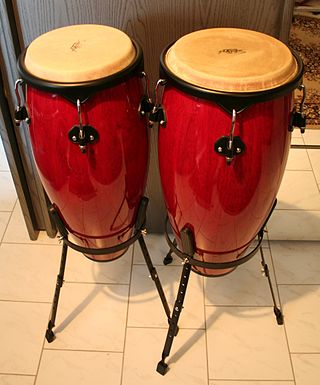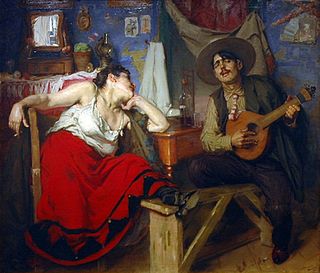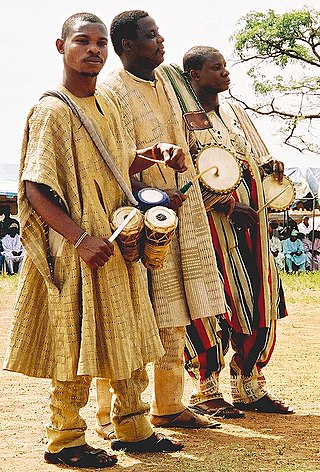Related Research Articles
The music of Latin America refers to music originating from Latin America, namely the Romance-speaking regions of the Americas south of the United States. Latin American music also incorporate the Indigenous peoples of the Americas. Due to its highly syncretic nature, Latin American music encompasses a wide variety of styles, including influential genres such as cumbia, bachata, bossa nova, merengue, rumba, salsa, samba, son, and tango. During the 20th century, many styles were influenced by the music of the United States giving rise to genres such as Latin pop, rock, jazz, hip hop, and reggaeton.

Salsa music is a style of Latin American music, combining elements of Cuban, Puerto Rican, and American influences. Because most of the basic musical components predate the labeling of salsa, there have been many controversies regarding its origin. Most songs considered as salsa are primarily based on son montuno and son cubano, with elements of guaracha, cha-cha-chá, danzón, descarga, bolero, guajira, rumba, mambo, jazz, funk, R&B, rock, bomba, and plena. All of these elements are adapted to fit the basic Son montuno template when performed within the context of salsa.

Fado is a music genre which can be traced to the 1820s in Lisbon, Portugal, but probably has much earlier origins. Fado historian and scholar Rui Vieira Nery states that "the only reliable information on the history of fado was orally transmitted and goes back to the 1820s and 1830s at best. But even that information was frequently modified within the generational transmission process that made it reach us today."

The Music of Puerto Rico has evolved as a heterogeneous and dynamic product of diverse cultural resources. The most conspicuous musical sources of Puerto Rico have primarily included African, Taino Indigenous, and European influences. Puerto Rican music culture today comprises a wide and rich variety of genres, ranging from essentially native genres such as bomba, jíbaro, seis, danza, and plena to more recent hybrid genres such as salsa, Latin trap and reggaeton. Broadly conceived, the realm of "Puerto Rican music" should naturally comprise the music culture of the millions of people of Puerto Rican descent who have lived in the United States, especially in New York City. Their music, from salsa to the boleros of Rafael Hernández, cannot be separated from the music culture of Puerto Rico itself.

Portuguese music includes many different styles and genres, as a result of its history. These can be broadly divided into classical music, traditional/folk music and popular music and all of them have produced internationally successful acts, with the country seeing a recent expansion in musical styles, especially in popular music.
The Music of Andalusia encompasses a range of traditional and modern musical genres which originate in the territory of Andalusia in southern Spain. The most famous are copla and flamenco, the latter being sometimes used as a portmanteau term for various regional musical traditions within Andalusia. Today, Andalusia has a rich and thriving musical scene, which draws from its own musical traditions as well as from external influences such as salsa, jazz or pop music.

Saudade is an emotional state of melancholic or profoundly nostalgic longing for a beloved yet absent something or someone. It is often associated with a repressed understanding that one might never encounter the object of longing ever again. It is a recollection of feelings, experiences, places, or events, often elusive, that cause a sense of separation from the exciting, pleasant, or joyous sensations they once caused. It derives from the Latin word for solitude.
The Hausa are one of the largest ethnic groups in Nigeria, Niger, Ghana, Sudan, Cameroon and in many other West and Central African countries. Their folk music has played an important part in the development of Nigerian music, contributing such elements as the Goje, a one-stringed fiddle. There are two broad categories of traditional Hausa music: rural folk music and urban court music. They introduced the African pop culture genre that is still popular today.

Yoruba music is the pattern/style of music practiced by the Yoruba people of Nigeria, Togo, and Benin. It is perhaps best known for its extremely advanced drumming tradition and techniques, especially using the gongon hourglass shape tension drums. Yoruba folk music became perhaps the most prominent kind of West African music in Afro-Latin and Caribbean musical styles; it left an especially important influence on the music used in Santería practice and the music of Cuba.

American popular music has had a profound effect on music across the world. The country has seen the rise of popular styles that have had a significant influence on global culture, including ragtime, blues, jazz, swing, rock, bluegrass, country, R&B, doo wop, gospel, soul, funk, pop, punk, disco, house, techno, salsa, grunge and hip hop. In addition, the American music industry is quite diverse, supporting a number of regional styles such as zydeco, klezmer and slack-key.
Marrabenta is a popular style of Mozambican dance music combining traditional Mozambican dance rhythms with Portuguese folk music. It was developed in Maputo, the capital city of Mozambique, during the 1930s and 1940s.
Salsa Romántica is a soft form of salsa music that emerged between the mid-1980s and early 1990s in New York City, Puerto Rico, and the Dominican Republic. It has been the most commercially successful form of salsa in the last 20 years, despite criticism that it is a pale imitation of "real" salsa, often called "salsa dura".{{Citation needed|reason=There is no source to this fact|date=February 2023}}
This is a timeline of music in the United States from 1970 to the present.
Latin soul was a short-lived musical genre that had developed in the 1960s in New York City. It had consisted of a blend of Cuban music such as mambo, along with elements of Latin jazz and soul music. Although short-lived, the genre had a very great influence on the growing Salsa movement which would dominate the New York Latin music scene in the 1970s. Today, the term is typically used for artists of Hispanic and Latin American descent producing R&B and/or soul music.
Twoubadou music is a popular genre of guitar-based music from Haiti that has a long and important place in Haitian culture. The word comes from troubadour, a medieval poet-musician who wrote and sang songs about courtly love. Like the troubadours of old, the Haitian twoubadou is a singer-composer who accompanies himself on songs that tell about the bitterness and humor of love, often using risqué or suggestive lyrics.
References
- Broughton, Simon and Mark Ellingham (eds.) (2000). Rough Guide to World Music (First ed.). London: Rough Guides. ISBN 1-85828-636-0.
{{cite book}}:|author=has generic name (help) - Gallop, Rodney (1936). Portugal: A Book of Folk-ways. Cambridge: Cambridge University Press., Aubrey Bell, in this work, is cited in Manuel, Popular Musics, pg. 274
- Manuel, Peter (1988). Popular Musics of the Non-Western World. New York: Oxford University Press. ISBN 0-19-505342-7.
- Manuel, Peter (1988). Popular Musics of the Non-Western World. New York: Oxford University Press. pp. 46–50. ISBN 0-19-506334-1.
- Morales, ed. (2003). The Latin Beat. Da Capo Press. ISBN 0-306-81018-2.
- Ritchie, Fiona (2004). The NPR Curious Listener's Guide to Celtic Music . New York: Berkley Publishing Group. ISBN 0-399-53071-1.